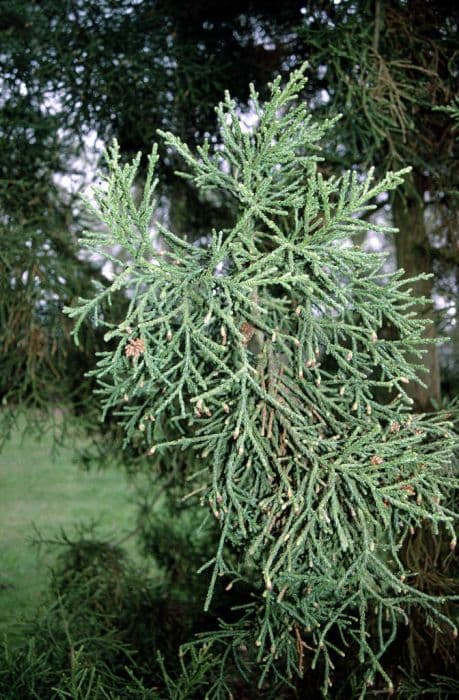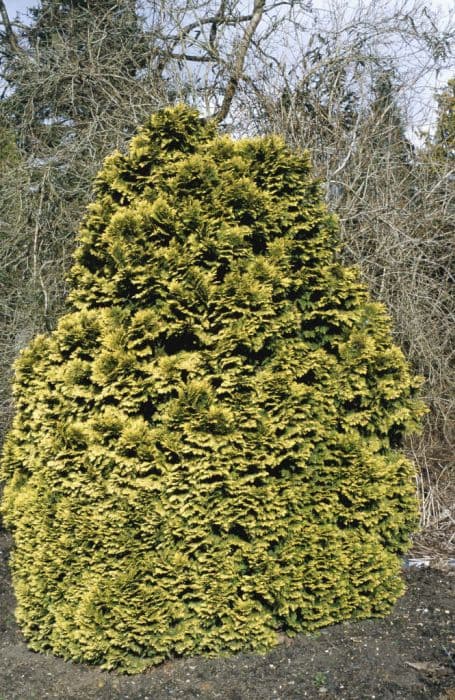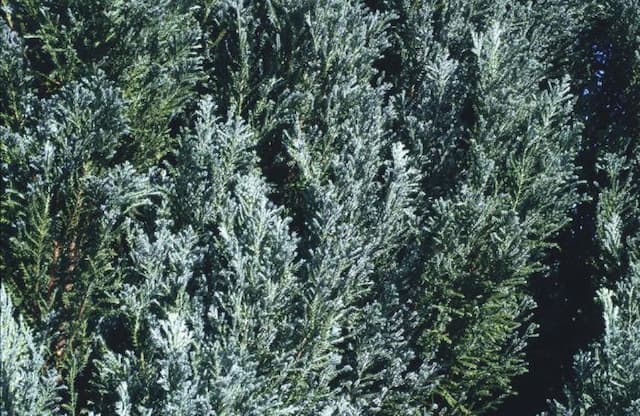Lawson's Cypress Chamaecyparis lawsoniana 'Wissel's Saguaro'











ABOUT
The Chamaecyparis lawsoniana 'Wissel's Saguaro', also known as the Lawson cypress or more specifically 'Wissel's Saguaro', is a uniquely structured coniferous plant that resembles the famous cacti of the American Southwest, the Saguaro cactus. The foliage of this Lawson cypress cultivar is deep green, giving it a rich, textured appearance. The needles are arranged in flattened sprays, offering a soft, feathery look upon touch. The most distinctive feature of 'Wissel's Saguaro' is its narrow, upright growth habit, which forms a slim columnar shape. The branches extend almost vertically with slight curving, mimicking the arms of a Saguaro cactus, which gives the plant its namesake. This sculptural quality makes the plant stand out in landscapes for its remarkable and unusual form. It is this cactus-like silhouette that provides year-round interest, with the foliage sometimes taking on a slightly bluish or purplish tint in colder conditions, adding to its visual appeal. Overall, 'Wissel's Saguaro' offers a compelling and striking presence with its vertical lines and dense, evergreen foliage, making it a popular choice for gardeners seeking a plant with distinctive character and form.
About this plant
 Names
NamesFamily
Cupressaceae
Synonyms
Wissel's Saguaro Lawson Cypress, Wissel's Saguaro False Cypress
Common names
Chamaecyparis lawsoniana 'Wissel's Saguaro'.
 Toxicity
ToxicityTo humans
The plant commonly known as Lawson's Cypress is not typically considered toxic to humans. However, if any part of the plant is ingested, it is advisable to watch for any unusual symptoms or reactions due to the potential for individual sensitivities, and seek medical attention if necessary. The plant is mainly a concern for its potential to cause skin irritation or allergic reactions in some individuals upon handling.
To pets
The Lawson's Cypress is not generally known to be toxic to pets. However, as with humans, individual animals may have varying sensitivities. Ingesting parts of the plant may potentially cause mild stomach upset in some pets, although significant toxicity is not expected. It is always best to prevent pets from eating plants, and if any signs of illness occur, consult a veterinarian.
 Characteristics
CharacteristicsLife cycle
Perennials
Foliage type
Evergreen
Color of leaves
Green
Height
10-15 feet (3-4.5 meters)
Spread
1-3 feet (0.3-0.9 meters)
Plant type
Tree
Hardiness zones
5-8
Native area
North America
Benefits
 General Benefits
General Benefits- Ornamental Value: Adds visual interest to landscapes with its unique, cactus-like shape.
- Drought Resistance: Once established, it requires less water, suitable for xeriscaping.
- Cold Tolerance: Can withstand cold climates, making it versatile for various hardiness zones.
- Wildlife Habitat: Provides shelter for birds and other wildlife within its dense foliage.
- Low Maintenance: Requires minimal pruning and care compared to other ornamental plants.
- Windbreak: Its thick foliage and sturdy form can act as a wind barrier in gardens and landscapes.
- Privacy Screening: Can be used to create private spaces due to its dense growth habit.
- Soil Erosion Control: The root system helps to stabilize soil and prevent erosion.
- Year-Round Interest: Evergreen nature ensures that it provides color and structure throughout the year.
 Medical Properties
Medical PropertiesThis plant is not used for medical purposes.
 Air-purifying Qualities
Air-purifying QualitiesThis plant is not specifically known for air purifying qualities.
 Other Uses
Other Uses- The Lawson cypress 'Wissel's Saguaro' can be used in thematic gardens due to its distinct shape, reminiscent of the Saguaro cactus, for a desert-like landscape in cooler climates.
- Incorporating this variety into a sensory garden can provide a unique tactile experience, as its scaly leaves offer a different feel compared to other plants.
- Applying the tree's dried, crushed foliage as a natural pest repellent in gardens due to its aromatic properties which some pests may find undesirable.
- Using its wood shavings as mulch, providing an ornamental appearance to garden beds while also helping to retain moisture in the soil.
- Lawson cypress 'Wissel's Saguaro' serves as an artistic inspiration for sculptures and topiaries because of its unusual, upright growth habit.
- The tree's conical form and symmetrical growth make it suitable for festive decorations, especially during the winter holidays.
- Its branches can be harvested and used for creating decorative wreaths and other craft items due to their pliability when fresh.
- Lawson cypress 'Wissel's Saguaro' can be utilized in noise reduction designs for landscapes, as the dense foliage can help muffle sound.
- As a natural windbreak or privacy screen due to its tall and slender growth habit, especially when planted in rows or groups.
- Ecologically, the plant can serve as a habitat for birds and beneficial insects, providing nesting places and shelter within a garden ecosystem.
Interesting Facts
 Feng Shui
Feng ShuiThe Lawson's Cypress is not used in Feng Shui practice.
 Zodiac Sign Compitability
Zodiac Sign CompitabilityThe Lawson's Cypress is not used in astrology practice.
 Plant Symbolism
Plant Symbolism- Endurance and Resilience: Inspired by the natural habitat of the ‘Wissel's Saguaro’ cypress, which often grows in challenging conditions, it symbolizes the ability to withstand difficult environments and circumstances.
- Longevity: The cypress family is known for its long-lived species, and as such, ‘Wissel's Saguaro’ cypress represents long life and timeless endurance.
- Protection: Historically, cypress trees have been associated with protection, as they were often planted in graveyards to protect the dead. This extends the symbolism to ‘Wissel's Saguaro’ cypress, offering a sense of guardianship and safety.
- Peace and Tranquility: The serene appearance of the cypress tree lends itself to symbolize peace and tranquility, a common association for ‘Wissel's Saguaro’ cypress as well.
 Water
WaterThe Lawson's Cypress, commonly known as Wissel's Saguaro, requires consistent moisture but does not like to be waterlogged. It should be watered thoroughly to ensure the root ball is moist, usually about once a week, depending on the climate and soil conditions. During the hotter seasons or in dryer climates, it may require watering twice a week, supplying approximately 1 to 1.5 gallons of water each time to maintain healthy growth. It's important to reduce the frequency of watering during the winter months when the plant's water requirements decrease. Always check that the top inch of soil is dry before watering again to avoid overwatering.
 Light
LightLawson's Cypress thrives best in full sun to partial shade conditions. Ideally, it should receive at least six hours of direct sunlight daily. It's best situated in a spot that provides morning sun and some afternoon shade to protect it from the intense heat of the day, which makes it suitable for a sunny border or as a focal point in the garden where it can receive ample light throughout the day.
 Temperature
TemperatureLawson's Cypress, or Wissel's Saguaro, is tolerant of a range of temperatures but grows best when the temperature is between 40°F and 70°F. It can survive minimum temperatures of about -20°F and is hardy in zones 5 through 8, making it suitable for various climates. The ideal growing conditions do not include extreme heat, so during the summer, it's important that the plant is not exposed to temperatures consistently above 80°F.
 Pruning
PruningPruning of Lawson's Cypress or Wissel's Saguaro is primarily for shaping and removal of damaged branches. It should be pruned in the late winter or early spring before new growth starts. It's typically pruned once a year to maintain its unique shape or to control its size within the landscape. Always use clean, sharp pruning tools to make precise cuts.
 Cleaning
CleaningNot needed
 Soil
SoilThe Lawson's Cypress 'Wissel's Saguaro' prefers well-draining soil with a mix of peat, compost, and sand with a pH between 5.0 and 7.0 for optimal growth.
 Repotting
RepottingThe Lawson's Cypress 'Wissel's Saguaro' should be repotted every 2 to 3 years to prevent becoming root-bound and to replenish its nutrients.
 Humidity & Misting
Humidity & MistingThe Lawson's Cypress 'Wissel's Saguaro' thrives best in moderate to high humidity levels but is generally adaptable to average outdoor humidity conditions.
 Suitable locations
Suitable locationsIndoor
Provide bright light, cool temps and avoid overheating spaces.
Outdoor
Plant in well-drained soil, full sun to partial shade.
Hardiness zone
5-8 USDA
 Life cycle
Life cycleThe Lawson's Cypress 'Wissel's Saguaro' begins its life as a seed, typically requiring stratification—a period of cold treatment—to break dormancy. Upon germination, the seedling emerges, establishing a root system and sprouting its first juvenile leaves, which are different in shape from adult foliage. As a young plant, 'Wissel's Saguaro' grows upward with a distinctive, upright and spiraling form, developing scale-like adult leaves and its characteristic blue-green to silvery foliage. During its maturation phase, which can take several years, it continues to grow, eventually reaching up to 15 feet tall and 5 feet wide. Once mature, it produces small, inconspicuous cones that carry the seeds for the next generation, completing its reproductive cycle. The plant can live for many years, often several decades, before eventually succumbing to old age or environmental stressors.
 Propogation
PropogationPropogation time
Spring-Early Summer
The Chamaecyparis lawsoniana 'Wissel's Saguaro', commonly known as the Lawson's cypress 'Wissel's Saguaro', is typically propagated through semi-hardwood cuttings. The optimal time for taking cuttings is later summer to early autumn. To propagate, a 4 to 6 inch cutting is selected from a healthy, disease-free parent plant. Leaves from the lower half of the stem are removed, and the cut end is dipped in rooting hormone powder to enhance root development. The cutting is then placed in a well-draining rooting medium, such as a mixture of peat and perlite, and kept under high humidity and indirect light until roots have established, which typically takes a few weeks to a few months. Regular misting and a consistent temperature of about 70 degrees Fahrenheit (21 degrees Celsius) are crucial for successful rooting. Once rooted, the new plants can be transplanted to individual pots and eventually moved to their permanent location in the garden.









